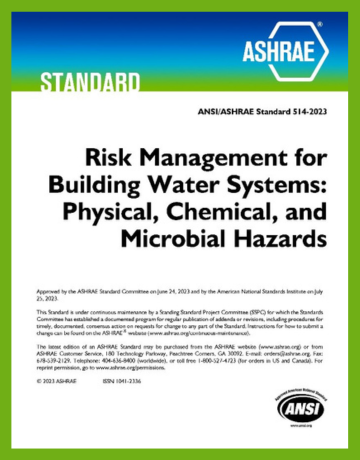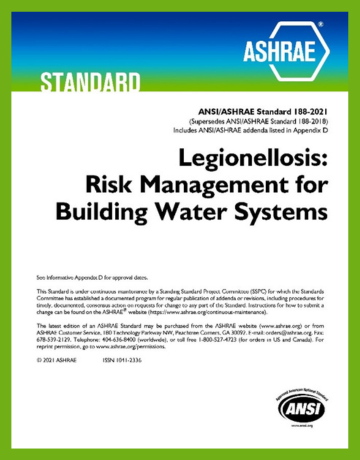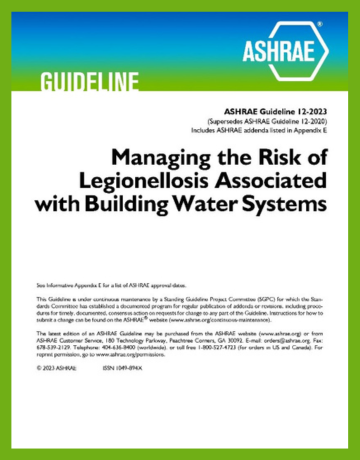Water system design directly affects the potential growth of microbial hazards, such as Legionnaire’s Disease and Pontiac Fever (legionellosis), that can negatively impact human health. Mitigation methods designed to eliminate or reduce the potential for microbial growth carry their own associated physical and chemical hazards.
ASHRAE’s Water System Risk Management suite of standards and guidelines provides minimum requirements and informative guidance for the design of building water systems that reduces the risk of microbial growth and provides measures for microbial control and the associated hazards.
These publications are intended for use by owners and managers of human-occupied buildings and those involved in the design, construction, installation, start-up, operation, maintenance, and service of centralized building water systems and components. Click the links above to find out more.
additional resources

|
ANSI/ASHRAE Standard 514,
Risk Management for Building Water Systems: Physical, Chemical, and Microbial Hazards
Purchase
|
Where Standard 188 and Guideline 12 focus on harmful disease associated with legionella, Standard 514 pulls back to address microbial risk more broadly, and the associated physical and chemical hazards associated with its mitigation. It provides minimum requirements for managing risk associated with building water systems and a framework for the systematic development of water management programs, from design and construction to occupancy, including post-occupancy modifications and renovations.
Risk Management in Health Care Facilities
Occupants in health care facilities can be particularly susceptible to microbial hazards and the risks associated with their mitigation. Standard 514 includes sections dedicated to risk management in these facilities, with minimum requirements and informative guidance for water management program development that covers building water system analysis, control measures, monitoring, corrective actions, and program confirmation.
Microbial Risk
Standard 514 takes a systematic approach to risk mitigation for opportunistic pathogens that can survive and grow in building water systems. It incorporates best practices for Legionella control found in Standard 188 and expands on them to address other microbes found in building water systems that may pose a risk to building occupants. An informative appendix provides background information on microbial hazards, including how they can cause illness and injury and what conditions might increase their abundance in building water systems, as well as potential measures for their control.
Physical Risk
Building water system design should account for the risk associated with unintended adverse consequences of both physical and chemical microbial mitigation methods. Standard 514 addresses the physical hazard of water at temperatures sufficient to cause scalding, particularly the risk to children and the elderly, who may be susceptible at lower temperatures and shorter exposures than healthy young and middle-aged adults.
Chemical Risk
Chemical hazards addressed by Standard 514 include disinfectants, disinfection byproducts, corrosion products, and chemicals that leach from plumbing materials, and include both regulated and unregulated chemicals.
| return to top

|
ANSI/ ASHRAE Standard 188,
Legionellosis: Risk Management for Building Water Systems
|
Every year, the CDC estimates there are between 8000 and 18,000 cases of Legionnaire's Disease in the United States. More than 10% of those cases are fatal. Managing the threat of legionella is critical for building occupant safety.
ASHRAE Standard 188 establishes minimum requirements for legionellosis risk management. It includes provision for conducting a building survey; outlines the principles and development of a water management program; describes preventive measures; and provides requirements for the design of building water systems, including documentation, balancing, and commissioning.
Appendices provide special requirements for health care facilities, as well as informative guidance for legionella testing when an outbreak is suspected or confirmed.
Standard 188 is an essential companion for anyone involved in design, construction, installation, commissioning, operation, maintenance, and service of centralized building water systems and components.
| return to top

|
ASHRAE Guideline 12,
Managing the Risk of Legionellosis Associated with Building Water Systems
Purchase
|
ASHRAE Guideline 12 provides useful information on legionellosis risk management, as well as guidance for complying with ASHRAE Standard 188. It discusses factors that lead legionella to spread in building water systems and reviews in detail some common areas for risk, including potable water systems; decorative water features; whirlpool spas/hot tubs; cooling towers and condensers; air coolers, misters, and humidifiers; and more.
Appendices provide additional discussion of U.S. regulations for drinking water treatment, legionella testing, and guidance for personal protective equipment (PPE) use where there is potential for exposure to contamination.
Guideline 12 is designed for use with ASHRAE Standard 188.
| return to top
Additional Resources from ASHRAE and Allied Associations